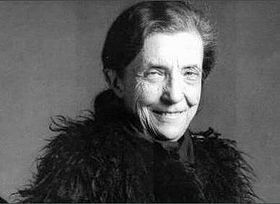
Louise Bourgeois
Louise Bourgeois, a French-American artist renowned for her expansive sculptures and installation art, was also a highly productive painter and printmaker. Her diverse body of work explores themes such as domesticity and the family, sexuality and the body, as well as death and the unconscious.
Biography of Louise Bourgeois
Born in 1911 in Paris, France, Louise Joséphine Bourgeois hailed from a family deeply immersed in the art world. Her family's gallery specialized in antique tapestries, exposing Louise and her siblings to a rich array of artworks and their creators from an early age.
Initially drawn to mathematics and geometry, Bourgeois enrolled at the Sorbonne in 1930. However, a profound personal loss, the sudden death of her mother, led her to shift her focus from mathematics to art in 1932.
Completing her studies at the Sorbonne in 1935, Louise delved into the world of art in Paris. She commenced her artistic education at the École des Beaux-Arts and later pursued advanced studies at the renowned École du Louvre. To further refine her skills, Bourgeois attended private classes at independent schools.
Pausing her strained relationship with her father, they collaborated on opening a print store alongside his tapestry workshop. Around the same time, Louise met her future husband, and together they relocated to New York City. She continued her artistic journey at the Art Students League of New York, studying under Vaclav Vytlacil and honing her skills in painting, sculpture, and printmaking.
In 1954, Louise Bourgeois joined the American Abstract Artists Group, establishing connections with contemporaries like Barnett Newman and Ad Reinhardt, as well as forming friendships with renowned artists such as Willem de Kooning, Mark Rothko, and Jackson Pollock.
During the early 1970s, Bourgeois hosted gatherings at her Chelsea home, dubbing them "Sunday, bloody Sundays.'" In 1973, she embarked on a teaching career at institutions like the Pratt Institute, Cooper Union, Brooklyn College, and the New York Studio School of Drawing, Painting, and Sculpture. From 1974 to 1977, she taught printmaking and sculpture at the School of Visual Arts in New York and also contributed her expertise to public schools in Great Neck, Long Island.
Nearly a decade later, in 1982, Bourgeois achieved a milestone with her first retrospective show at the esteemed Museum of Modern Art in New York City. Tragically, she passed away on May 31, 2010, succumbing to heart failure at the Beth Israel Medical Center in Manhattan.
Louise Bourgeois's Art Style
Louise Bourgeois crafted her works from discarded materials found in junkyards and driftwood, shaping them into upright wood sculptures. While in Paris, she was linked to Surrealist concepts through the incorporation of fantastical elements in her printed pieces. However, upon her move to New York in the late 1930s, her focus shifted predominantly to sculpture, exploring themes related to the female form, dreamlike imagery, sexuality, pain, and fear.
Bourgeois frequently employed unconventional materials like resin, latex, and cloth in her art. As a member of the American Abstract Artists Group, she transitioned from using wood to relying on marble, plaster, and bronze in her sculptural compositions.
Notable works such as "Femme Maison" (1946–1947), "Torso self-portrait" (1963–1964), and "Arch of Hysteria" (1993) all intricately portray the feminine body. One of her impactful pieces, "Destruction of the Father" (1974), serves as both a biographical and psychological exploration of paternal dominance and its repercussions. The installation, created from plaster, latex, wood, fabric, and red light, marks a departure as it incorporates soft materials on a large scale.
In the year 2010, Bourgeois used her art as a platform to advocate for Lesbian, Gay, Bisexual, and Transgender (LGBT) equality.
Years:
Born in 1911
Country:
United States of America, New York
Gallery: